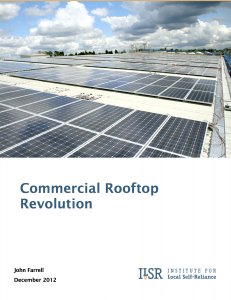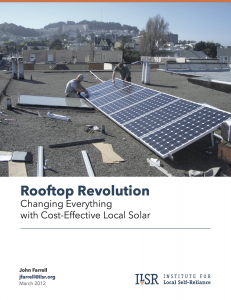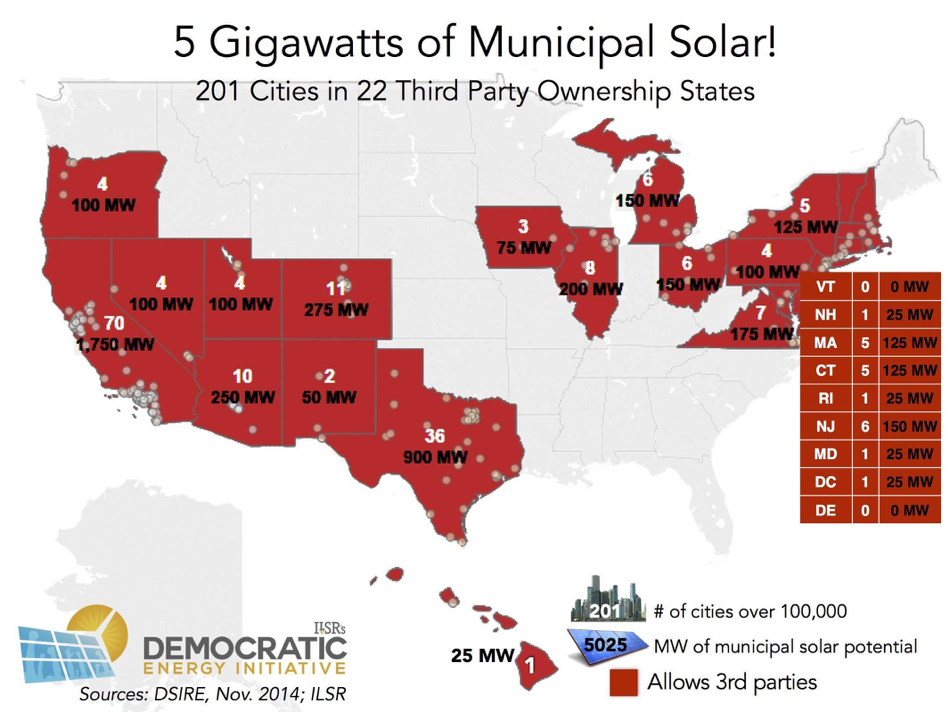There are a lot of stories on residential rooftop solar but few if any on what cities are doing to make themselves energy self-reliant by using their own buildings and lands to generate power.
In Public Rooftop Revolution, ILSR estimates that mid-sized cities could install as much as 5,000 megawatts of solar—as much as one-quarter of all solar installed in the U.S. to date—on municipal property, with little to no upfront cash. It would allow cities to redirect millions in saved energy costs to other public purposes.
This report is being released in serial format, beginning Monday, June 1 through Thursday, June 4. CHECK BACK TOMORROW FOR UPDATES.
Read the Executive Summary
Read Part 1 of the report
Read Part 2 of the report
Read Part 3 of the report
Listen to our podcast conversations with a few of our Featured Five municipal solar cities:
Lancaster, CA city manager Jason Caudle, listen to the podcast, read the interview summary.
Raleigh, NC renewable energy coordinator Robert Hinson, listen to the podcast, read the interview summary.
Spillover Effects of Municipal Solar
Municipal solar installations serve a purpose beyond city energy savings. Their presence on city buildings supports solar development in the private sector in several ways:
- Copycat: The visibility of solar on public buildings can inspire individual residents or businesses to invest in solar.
- Market experience: Public building installations also provide valuable installation experience to local solar companies, driving down costs.
- Internal experience: The installation of solar arrays on public buildings provides valuable experience to affected city staff such as building, electrical, and fire code officials who regulate the private solar market.
- Local policy: The city’s interest in solar can lead to more favorable rules and regulations for private solar installations, reducing permitting and licensing requirements. Denver, CO, is given a “Best” score by Vote Solar, and has among the easiest and lowest cost permitting rules in Colorado. Lancaster, CA, is given a “Good” score from Vote Solar, with many streamlined processes. New Bedford, MA, has below average permitting fees compared to other Massachusetts municipalities. Kansas City shortened permit waiting times to 8 hours or less, provided online permitting, and lowered inspection times to eight hours or less.
- State policy: A municipal solar project may also help change state policy. In Dubuque, IA, a proposed solar installation using a power purchase agreement sparked a legal battle when the utility objected. The Iowa Supreme Court ultimately determined that power purchase agreements were legal, and the ruling has generated substantially more interest in public sector solar installations.
Solar on public buildings can also serve as a starting point for municipal interest in deeper clean energy opportunities, beyond solar. Municipal electric vehicles could charge from municipal solar arrays, for example, as they do in Lansing, MI. City buildings with solar could also incorporate storage, making them safe severe weather shelters. Florida’s SunSmart Schools and Emergency Shelters Program has installed 115 10-kW PV systems with electricity storage at Florida’s schools to create emergency shelters. Rutland, VT, is building a microgrid with solar plus battery storage to power the public shelter during severe weather emergencies. New York City is interested in installing 800 megawatts of distributed generation, and the city’s not-for-profit economic development corporation is planning a large battery storage system at the Brooklyn Army Terminal.
Solar on city buildings has many benefits, from energy savings to jobs to greenhouse gas emissions reductions. But it also builds city experience in managing its own energy consumption and in driving a cleaner and more efficient local energy economy.
Summary
Only a few cities have realized the advantages of siting solar energy generation on their buildings. The most likely reason is the only-recent affordability of solar, but also that solar is a new entrant in the competition for a city’s capital and/or operating budget.
For many cities, these barriers are easily overcome. Third party ownership allows them to have solar installed on public property at zero upfront cost and often with immediate savings to the city’s energy budget. Savings can be large enough, especially over time, to free up additional operating or debt service funds. It’s a gift that keeps giving, since many third party arrangements allow the city to assume ownership of the solar arrays at minimal cost after 15-20 years, allowing for many more years of energy savings.
Cities with this simple solar option and that have commitments to reduce greenhouse gas emissions should be especially eager to maximize their solar potential, since the savings are to the “triple bottom line”––financial, environmental, and social.
Not only can city-installed solar reduce environmental and financial impacts on the city, but it creates local jobs and generates experience for solar installers, and can serve as an example for private market solar development. There are several examples of cities with substantial municipal solar installations providing much easier permitting and inspection requirements for solar development.
Barriers remain to city-installed solar. Cities in half of U.S. states still lack access to the power purchase arrangement that minimizes their financial risk. Net metering rules in most states require cities to match their solar installations with on-site building load, limiting the utility of their many rooftops to those that are suitable, sunny, and serve significant on-site energy use. Many cities lack the internal expertise to pursue solar.
Our Featured Five cities show how these barriers are surmountable. Even in states with the least favorable policy, cities like Kansas City and Raleigh are making solar work. And these cities can be models and teachers for the cities that have yet to take up the solar charge.
Cities have a unique opportunity to cut costs and emissions, boost the economy, and stimulate their solar market with investments in solar on municipal buildings. What are they waiting for?
Appendix
Actual solar PPA terms used to inform this analysis (no upfront cost unless mentioned)
- California City, CA––20 years, guarantee of 80% performance, seller owns renewable energy credits (RECs), initial price of 9.5¢ per kilowatt-hour (kWh) with a 1.5% per year escalator, assumption of 0.25% panel degradation.
- Minneapolis––20 years, 10.7¢ per kWh fixed, RECs belong to utility (which provided a grant with ratepayer money worth 65% of project cost), city may buy out at year 7 at 14% of initial cost.
- Lancaster, CA
- Power Authority agreement––25 year term, 9¢ per kWh, escalating at 1.5% annually, Power Authority makes a prepayment of (9¢ * 85% of expected energy generation in year 1 * 9% discount rate).
- Lancaster City Hall––15 years with extensions, 10¢ per kWh fixed price, purchase option at year 6 for $1.8 million, year 10 at $1.69 million, year 15 at fair market value. Termination value in year 1 = $5.37 million.
References
This article originally posted at ilsr.org. For timely updates, follow John Farrell on Twitter or get the Democratic Energy weekly update.
Rooftop Revolution: Past Reports
In 2012, ILSR published a pair of reports that projected, by 2021,10% of electricity in the U.S. could come from solar and at a lower price—without subsidies—than utility-provided electricity. In 2014 and 2015, Environment America’s Shining Cities reports examined how cities were catalysts for solar development.
By 2022, over 38 million homes and businesses could get solar power from their own rooftop, pay less for electricity, without any subsidies for solar. These two reports, published in 2012, outline the growth potential for local solar power and the coming rooftop revolution. Click to see more of our Rooftop Revolution resources.
 |
 |






